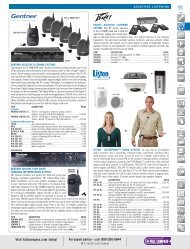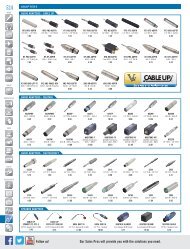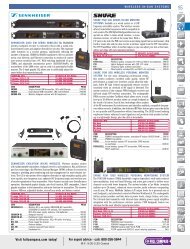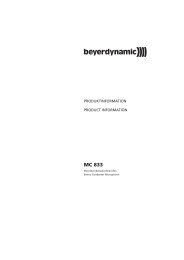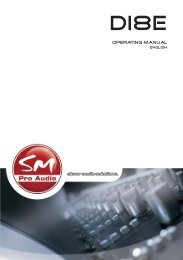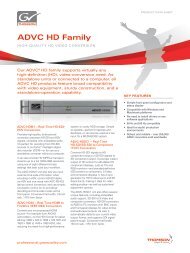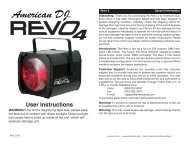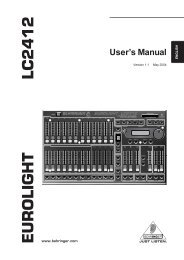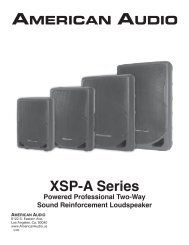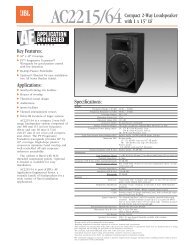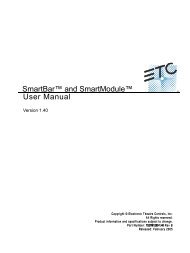Download the XML410 English User Manual in PDF format - Samson
Download the XML410 English User Manual in PDF format - Samson
Download the XML410 English User Manual in PDF format - Samson
You also want an ePaper? Increase the reach of your titles
YUMPU automatically turns print PDFs into web optimized ePapers that Google loves.
Speaker Outputs - <strong>XML410</strong><br />
The <strong>XML410</strong> conta<strong>in</strong>s two mono power amplifiers, and depend<strong>in</strong>g on <strong>the</strong> operat<strong>in</strong>g mode, <strong>the</strong> two amplifiers can be<br />
used <strong>in</strong>dependently (maximum output 200W + 200W) or <strong>in</strong> BRIDGE mode (maximum output 400W).<br />
NOTE: Use <strong>the</strong> front panel Power Amp MODE switch to select which signal is sent to <strong>the</strong> speaker output jacks, and to<br />
activate BRIDGE mode.<br />
If <strong>the</strong> two power amplifiers are used for MAINS operation, two 8 Ohm speakers can be “daisy-cha<strong>in</strong>ed” toge<strong>the</strong>r and connected<br />
to <strong>the</strong> AMP 1 jack, and two more 8 Ohm speakers can be “daisy-cha<strong>in</strong>ed” toge<strong>the</strong>r and connected to <strong>the</strong> AMP 2<br />
jack, for a total of four speakers.<br />
The total impedance load for each amplifier must not exceed 4 Ohms. Therefore, <strong>in</strong> <strong>the</strong> example above, two speakers with<br />
an impedance of 8 Ohms each are connected to each amp’s output jacks.<br />
If you wish to use two amplifiers <strong>in</strong>dependently, let’s say for Ma<strong>in</strong> and Monitor operation, use a 4–8 Ohm speaker. Aga<strong>in</strong>,<br />
<strong>the</strong> total impedance load for each amplifier must not exceed 4 Ohms. Therefore, two speakers with an impedance of 8<br />
Ohms can be “daisy-cha<strong>in</strong>ed” toge<strong>the</strong>r and <strong>the</strong>n connected to each amp’s output jacks.<br />
If two amplifiers are used <strong>in</strong> a BRIDGE mode, only one speaker can be connected to <strong>the</strong> BRIDGE jack. The total impedance<br />
load while operat<strong>in</strong>g <strong>in</strong> BRIDGE mode must not be less than 8 Ohms. If you are connect<strong>in</strong>g a speaker to <strong>the</strong> BRIDGE jack,<br />
use an 8–16 Ohm speaker.<br />
CAUTION: When us<strong>in</strong>g a BRIDGE connection, do not connect anyth<strong>in</strong>g to <strong>the</strong> AMP 1 and AMP 2 jacks. Likewise, when us<strong>in</strong>g<br />
<strong>the</strong> AMP 1 and AMP 2 jacks, do not connect anyth<strong>in</strong>g to <strong>the</strong> BRIDGE jack.<br />
16<br />
44 46<br />
45<br />
44. AMP 1 Speaker Outputs - The AMP 1 output has one 1/4” phone connector, which is a powered output used to connect<br />
your ma<strong>in</strong> PA speaker when us<strong>in</strong>g <strong>the</strong> <strong>XML410</strong> <strong>in</strong> MAIN/MAIN mode. When operat<strong>in</strong>g <strong>in</strong> MAIN/MONITOR mode,<br />
<strong>the</strong> AMP 1 powered output connectors are used to connect left and right side MAIN PA speakers.<br />
45. AMP 2 Speaker Outputs - The AMP 2 output has one 1/4” phone connector, which is a powered output used to connect<br />
your ma<strong>in</strong> PA speaker when us<strong>in</strong>g <strong>the</strong> <strong>XML410</strong> <strong>in</strong> MAIN/MAIN mode. When operat<strong>in</strong>g <strong>in</strong> MAIN/MONITOR mode,<br />
<strong>the</strong> AMP 2 powered output connectors are used to connect to floor or side fill monitors fac<strong>in</strong>g <strong>the</strong> performers.<br />
46. BRIDGE Output connector - The BRIDGE output has one 1/4” phone connector, which is a powered output used to<br />
connect one ma<strong>in</strong> PA speaker when us<strong>in</strong>g <strong>the</strong> XM410 <strong>in</strong> BRIDGE mode.<br />
XML POWERED MIXERS




